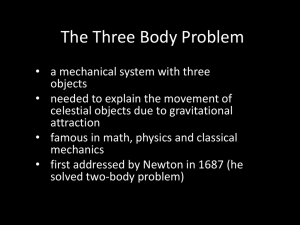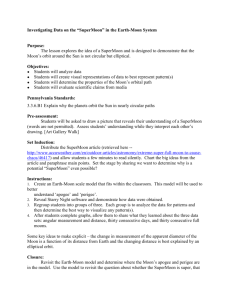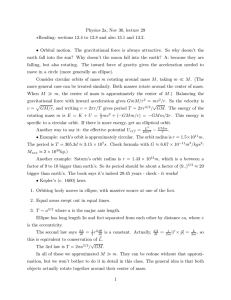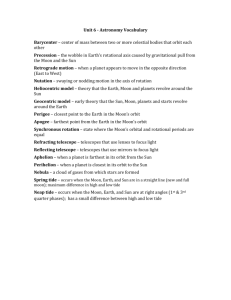Document 13352617
advertisement
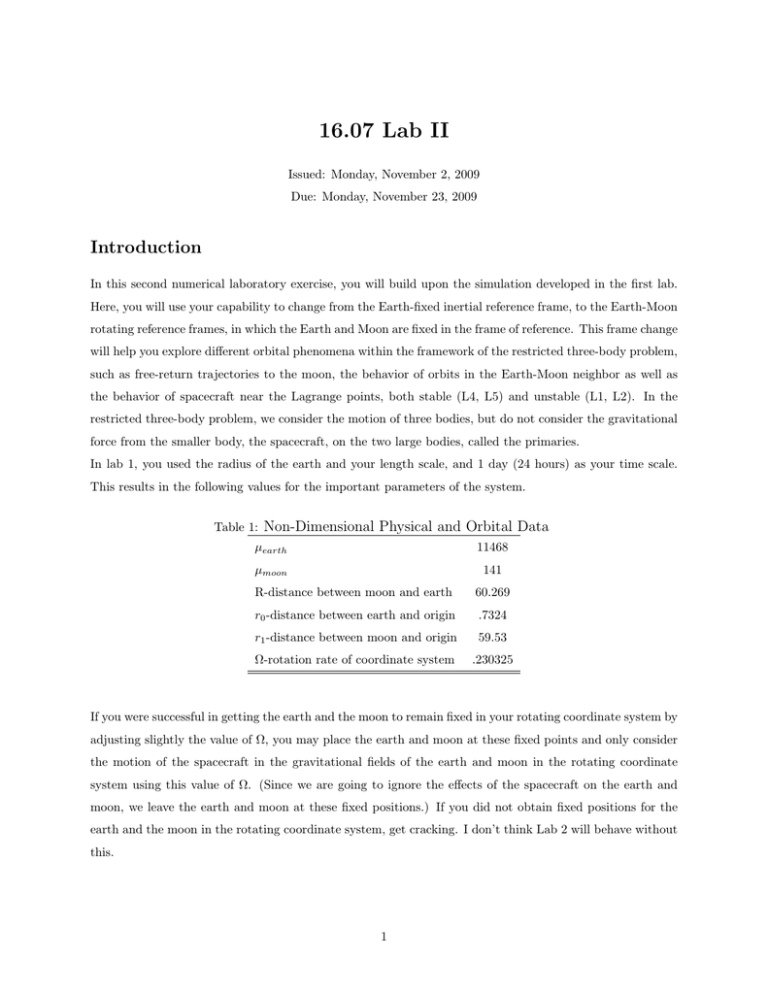
16.07 Lab II Issued: Monday, November 2, 2009 Due: Monday, November 23, 2009 Introduction In this second numerical laboratory exercise, you will build upon the simulation developed in the first lab. Here, you will use your capability to change from the Earth-fixed inertial reference frame, to the Earth-Moon rotating reference frames, in which the Earth and Moon are fixed in the frame of reference. This frame change will help you explore different orbital phenomena within the framework of the restricted three-body problem, such as free-return trajectories to the moon, the behavior of orbits in the Earth-Moon neighbor as well as the behavior of spacecraft near the Lagrange points, both stable (L4, L5) and unstable (L1, L2). In the restricted three-body problem, we consider the motion of three bodies, but do not consider the gravitational force from the smaller body, the spacecraft, on the two large bodies, called the primaries. In lab 1, you used the radius of the earth and your length scale, and 1 day (24 hours) as your time scale. This results in the following values for the important parameters of the system. Table 1: Non-Dimensional Physical and Orbital Data µearth 11468 µmoon 141 R-distance between moon and earth 60.269 r0 -distance between earth and origin .7324 r1 -distance between moon and origin 59.53 Ω-rotation rate of coordinate system .230325 If you were successful in getting the earth and the moon to remain fixed in your rotating coordinate system by adjusting slightly the value of Ω, you may place the earth and moon at these fixed points and only consider the motion of the spacecraft in the gravitational fields of the earth and moon in the rotating coordinate system using this value of Ω. (Since we are going to ignore the effects of the spacecraft on the earth and moon, we leave the earth and moon at these fixed positions.) If you did not obtain fixed positions for the earth and the moon in the rotating coordinate system, get cracking. I don’t think Lab 2 will behave without this. 1 Problems In the following problems, the items you must turn in—either the written answers to questions, or required plots—are highlighted in bold. The ordering of these deliverables in your report should match the ordering that appears below. 1.Earth Fixed Satellites In this problem, we revisit the restricted three-body problem simulation from Lab I. Our first task is to place a satellite in a circular orbit at a radius R from the center of the earth of magnitude R = 2Rearth . The proper choice of boundary conditions for this calculation is subtle. As shown in the figure, in an inertial coordinate system, placing a satellite in earth orbit requires matching the boundary condition with the rotation of the earth-moon system about its center of mass. Consider for simplicity only the insertion point directly beyond the earth, on the line joining the earth-moon centers, the line of symmetry. For a counterclockwise insertion, we would require a negative y velocity of magnitude relative to a fixed earth in an inertial frame. � vsi = − µ/rs (1) Therefore, when we move into the rotating coordinate system in which the earth and moon are fixed in our coordinate system, we obtain the following boundary conditions: � vs = ± µ/rs + Ω ∗ rs (2) where for a counterclockwise orbit with insertion point on the far side of the earth, the initial y veloc­ ity is negative; for a clockwise rotation, the y velocity is positive. Given the rotation of the earth, the counterclockwise rotation would be preferred. Your mission is to place a satellite in earth orbit at twice earth radius using the insertion point on the line of symmetry at the far side of the earth from the moon. Do both the clockwise and counterclockwise rotation. Verify that the orbits are circular to the accuracy of your calculations. Note that the time required to complete an orbit is slightly different for each direction. This has to do with the rotation of the coordinate system. 2A. Off to the Moon: First Attempt Now beginning with the insertion of the satellite in a counterclockwise obit at twice the radius of the earth from the back-side of the earth on the line of symmetry. Begin to increase the magnitude of the insertion � velocity above the magnitude required for a circular orbit. It is useful to scale the velocity as vs = A µ/rs and focus on determining A for interesting motions. For example, what is A to ”escape” earth’s orbit; this is clearly an upper limit on A, modified only slightly by the presence of the moon. 2 Run several cases from A = 1 to A < Aescape (Try A=1.36, 1.37, 1.38 and 1.39). What happens? Now insert the spacecraft at y3(0) = −2 and x3(0) = x1 where x1 is the position of the earth. Repeat your calculations for A = 1.39. Present 4 plots of your most interesting results. Interpret your results. Do you think you can get to the moon this way? 2B. Off to the Moon: Second Attempt The best way to get to the moon, is to go there and try to get back to the earth. Then use the image theorem and flip the orbit to get back to the moon—like the astronauts tossing cheeseburgers, remember how well that worked. Place a satellite in a planar x, y circular clockwise orbit around the moon at a radius of rsm . The point of insertion is on the far side of the moon on the line of symmetry joining the earth-moon. The choice of radius is up to you, but I had good luck with rsm = 1.4Rearth , rsm = Rearth and rsm = 2 ∗ Rearth with the mission ending up in a parking orbit around the earth at R = 2Rearth , and R = 1.5Rearth . Verify that a circular orbit results from your choice of initial condition. Now, defining the velocity for a circular orbit of radius rsm around the moon as vmoon , increase the velocity as v = A ∗ vmoon , for different values of A. The notion of escape velocity does not quite exist for the moon; you can escape the moon but you will be back in the influence of the earth–which is of course where you want to be. Now, the goal is to increase A until the resulting orbit passes close enough to the earth to be inserted into a parking orbit. You should be able to get the orbit from moon to earth at R = 2 ∗ Rearth and/or R = 1.5Rearth . Run several cases and determine A which makes this possible. Determine exactly what x(t), y(t), x� (t), y � (t) are for the conditions at the point at which the orbit is tangent to the earth parking orbit at 2 earth radii from the center of the earth. Also, at what elapsed time does the spacecraft arrive at this point on its return? Determine exactly what x(t), y(t), x� (t), y � (t) are for the point at which the orbit is 1.5 earth radii from the center of the earth. Also, at what elapsed time does the spacecraft arrive at this point? Recall that you are using 1 day as your time scale. Therefore, the time obtained is the time in days required to ”return” from the moon on a free-return trajectory. 3 2C. Off to the Moon: Application of the Image Theorem Now that you have successfully ”returned” from the moon, apply the image theorem to the return conditions at the parking orbit around the earth that you obtained from your calculation of the return trajectory. Use these as initial conditions for your trip to the moon. Go back on this ”image” trajectory to the moon, and continue the calculation until you whip around the moon and return to the vicinity of your parking orbit. Recall, that for the image theorem, you flip y and x� leaving x and y � unchanged. Use the final results from your first calculation, flip them, and apply them as initial conditions on the earth orbit for the next calculation. You should get to the moon whip around and return to earth on a free-return trajectory without human intervention being required–even I was blown away by the results! Present the results–a plot– for two free-return trajectories. What is the total time of flight required to get back to earth for each case. What is the ΔV required for each free-return trajectory. For c=4000, convert this to % mass required for each trip. Don’t forget to include the ΔV required to end up in a parking orbit around earth. 3. Behavior About Lagrange Points Consider two masses orbiting one another. The mathematician Lagrange showed that this system has 5 points of equilibrium. This means that a third body located at one of these Lagrange points will experience exactly the required acceleration to remain stationary in orbit relative to the other two bodies. The figure sketches the relative positions of the 5 Lagrange points. 4 The exact locations of the Lagrange points depend on the mass ratio of the two planets, M/m. For any mass ratio, L1 , L2 , and L3 are unstable. This means that bodies located there will slowly drift away. NASA’s SOHO solar observer telescope is located at the Sun-Earth L1 , but must frequently make small course corrections to stay in place. For mass ratios greater than about 25, the L4 and L5 points are stable. For instance, the Sun-Jupiter L4 and L5 points contain thousands of asteroids called the Trojan asteroids. In Lecture 18, we showed that for small α (α is the mass ratio between the two bodies; α = Mmoon /Mearth ), expressions could be obtained for the locations of the Lagrange points: L1 , L2 and L3 along the x axis. � � α �1/3 � XL1 = R 1 − (3) 3 � � � α �1/3 XL2 = R 1 + (4) 3 � � � �1/3 5α XL3 = −R 1 + (5) 12 The Lagrange point L4 is at a distance R from M2 and by symmetry from M1 : L4 is at positive y; L5 its mirror image. Since the masses are R apart on the x axis, the location of L4 is at the peak of an equilateral triangle: R on all three sides. Place a spacecraft at the L4 Lagrange point with a slight initial displacement or velocity (such as Δx0 = .01 and/or Δx�0 = .01). Play around. Present results for the orbit obtained. Present your results for its motion. 5 Now place a spacecraft at any point. I chose x = XL4 /2, y = YL4 . Investigate the motion and present the results. Extra Credit: Halo Orbits A variety of special motions can exist about L1 and L2 . These motions are in a family called halo orbits. They have been used for a variety of complex space missions including station keeping for such missions as the James Webb telescope. Although they are ”unstable” they require very little station-keeping, ΔV � s, to remain in orbit. We will play around with this but you might have to increase the accuracy of your numerical method. Now investigate motion about the Lagrange Point L2 . Recall that this is a saddle point: it is stable in the y direction, (and the z direction), but not in x. Place a spacecraft at x = X2 − 2.2, y = 0, with a velocity x�0 = 0(say),y � (0) = 2.250409557049. Play around changing the value of y3� 0 to produce a few cycles of an orbit. What motion ensues? Present a plot of your results. If you’re lucky and accurate, you should get a few cycles of the ”halo” orbit shown below before it goes zinging off. With proper initial conditions, such an orbit can cycle for 55 days without the need for station keeping. The initial conditions are very sensitive; the number of significant figures in my suggested y3� [0] should be a clue. Good luck! 6 Wrap-Up You should submit your file. Submit the script that runs all parts of the simulation, concatenates the solutions from the separate parts, and produces the required plots. Report Preparation There is no need to produce a fancy report. You should include all the figures requested and answer all the questions posed. If your write-up is neat, organized, and readable, then there is no need to type it. NOTE: LATE CODE AND REPORTS WILL NOT BE ACCEPTED. If you have schedule prob­ lems, plan ahead. 7 MIT OpenCourseWare http://ocw.mit.edu 16.07 Dynamics Fall 2009 For information about citing these materials or our Terms of Use, visit: http://ocw.mit.edu/terms.
